mTERF2 regulates oxidative phosphorylation by modulating mtDNA transcription
- PMID: 19490905
- PMCID: PMC2778471
- DOI: 10.1016/j.cmet.2009.04.010
mTERF2 regulates oxidative phosphorylation by modulating mtDNA transcription
Retraction in
-
Retraction Notice to: mTERF2 Regulates Oxidative Phosphorylation by Modulating mtDNA Transcription.Cell Metab. 2015 Oct 6;22(4):751. doi: 10.1016/j.cmet.2015.09.017. Cell Metab. 2015. PMID: 26693524 Free PMC article. No abstract available.
Abstract
Regulation of mitochondrial protein expression is crucial for the function of the oxidative phosphorylation (OXPHOS) system. Although the basal machinery for mitochondrial transcription is known, the regulatory mechanisms are not completely understood. Here, we characterized mTERF2, a mitochondria-localized homolog of the mitochondrial transcription termination factor mTERF1. We show that inactivation of mTERF2 in the mouse results in a myopathy and memory deficits associated with decreased levels of mitochondrial transcripts and imbalanced tRNA pool. These aberrations were associated with decreased steady-state levels of OXPHOS proteins causing a decrease in respiratory function. mTERF2 binds to the mtDNA promoter region, suggesting that it affects transcription initiation. In vitro interaction studies suggest that mtDNA mediates interactions between mTERF2 and mTERF3. Our results indicate that mTERF1, mTERF2, and mTERF3 regulate transcription by acting in the same site in the mtDNA promoter region and thereby mediate fine-tuning of mitochondrial transcription and hence OXPHOS function.
Figures
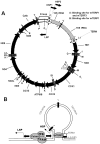
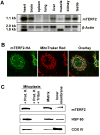

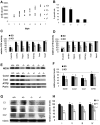

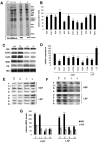
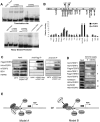
Similar articles
-
MTERF1 binds mtDNA to prevent transcriptional interference at the light-strand promoter but is dispensable for rRNA gene transcription regulation.Cell Metab. 2013 Apr 2;17(4):618-26. doi: 10.1016/j.cmet.2013.03.006. Cell Metab. 2013. PMID: 23562081
-
Mitochondrial transcription termination factor 2 binds to entire mitochondrial DNA and negatively regulates mitochondrial gene expression.Acta Biochim Biophys Sin (Shanghai). 2011 Jun;43(6):472-9. doi: 10.1093/abbs/gmr035. Epub 2011 May 9. Acta Biochim Biophys Sin (Shanghai). 2011. PMID: 21558281
-
MTERF3 is a negative regulator of mammalian mtDNA transcription.Cell. 2007 Jul 27;130(2):273-85. doi: 10.1016/j.cell.2007.05.046. Cell. 2007. PMID: 17662942
-
Mitochondrial transcription: lessons from mouse models.Biochim Biophys Acta. 2012 Sep-Oct;1819(9-10):961-9. doi: 10.1016/j.bbagrm.2011.11.001. Epub 2011 Nov 18. Biochim Biophys Acta. 2012. PMID: 22120174 Free PMC article. Review.
-
Mitochondrial transcription factor A regulates mitochondrial transcription initiation, DNA packaging, and genome copy number.Biochim Biophys Acta. 2012 Sep-Oct;1819(9-10):921-9. doi: 10.1016/j.bbagrm.2012.03.002. Epub 2012 Mar 21. Biochim Biophys Acta. 2012. PMID: 22465614 Review.
Cited by
-
The mTERF protein MOC1 terminates mitochondrial DNA transcription in the unicellular green alga Chlamydomonas reinhardtii.Nucleic Acids Res. 2013 Jul;41(13):6553-67. doi: 10.1093/nar/gkt313. Epub 2013 May 6. Nucleic Acids Res. 2013. PMID: 23649833 Free PMC article.
-
D-MTERF5 is a novel factor modulating transcription in Drosophila mitochondria.Mitochondrion. 2012 Sep;12(5):492-9. doi: 10.1016/j.mito.2012.06.010. Epub 2012 Jul 8. Mitochondrion. 2012. PMID: 22784680 Free PMC article.
-
Human mitochondrial transcription revisited: only TFAM and TFB2M are required for transcription of the mitochondrial genes in vitro.J Biol Chem. 2010 Jun 11;285(24):18129-33. doi: 10.1074/jbc.C110.128918. Epub 2010 Apr 21. J Biol Chem. 2010. PMID: 20410300 Free PMC article.
-
Nuclear respiratory factor 2 induces the expression of many but not all human proteins acting in mitochondrial DNA transcription and replication.J Biol Chem. 2010 Feb 5;285(6):3939-3948. doi: 10.1074/jbc.M109.044305. Epub 2009 Dec 1. J Biol Chem. 2010. PMID: 19951946 Free PMC article.
-
Effects on mitochondrial transcription of manipulating mTERF protein levels in cultured human HEK293 cells.BMC Mol Biol. 2010 Sep 16;11:72. doi: 10.1186/1471-2199-11-72. BMC Mol Biol. 2010. PMID: 20846394 Free PMC article.
References
-
- Antonicka H, Sasarman F, Kennaway NG, Shoubridge EA. The molecular basis for tissue specificity of the oxidative phosphorylation deficiencies in patients with mutations in the mitochondrial translation factor EFG1. Hum Mol Genet. 2006;15:1835–1846. - PubMed
-
- Asin-Cayuela J, Helm M, Attardi G. A monomer-to-trimer transition of the human mitochondrial transcription termination factor (mTERF) is associated with a loss of in vitro activity. J Biol Chem. 2004;279:15670–15677. - PubMed
-
- Bonawitz ND, Clayton DA, Shadel GS. Initiation and beyond: multiple functions of the human mitochondrial transcription machinery. Mol Cell. 2006;24:813–825. - PubMed
-
- Chomyn A. In vivo labeling and analysis of human mitochondrial translation products. Methods Enzymol. 1996;264:197–211. - PubMed
-
- Daga A, Micol V, Hess D, Aebersold R, Attardi G. Molecular characterization of the transcription termination factor from human mitochondria. J Biol Chem. 1993;268:8123–8130. - PubMed
Publication types
MeSH terms
Substances
Grants and funding
LinkOut - more resources
Full Text Sources
Molecular Biology Databases

